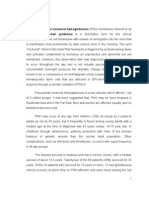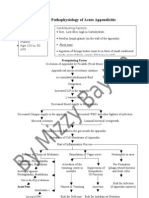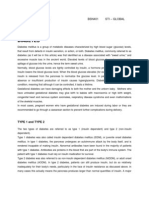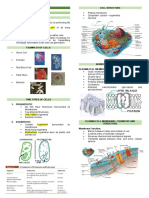Cystic Fibrosis Pathophysiology
Cystic Fibrosis Pathophysiology
Uploaded by
Kim Enrico JumarangCopyright:
Available Formats
Cystic Fibrosis Pathophysiology
Cystic Fibrosis Pathophysiology
Uploaded by
Kim Enrico JumarangOriginal Description:
Copyright
Available Formats
Share this document
Did you find this document useful?
Is this content inappropriate?
Copyright:
Available Formats
Cystic Fibrosis Pathophysiology
Cystic Fibrosis Pathophysiology
Uploaded by
Kim Enrico JumarangCopyright:
Available Formats
CYSTIC FIBROSIS Pathophysiology (Lung-Specific)
Cystic fibrosis affects many parts of the body. The most notable manifestation is in the lungs and in the pancreas. Patients often suffer from multiple lung infections. The underlying issue is the lack of a crucial protein (the Cystic Fibrosis Transmembrane Conductance Regulator or CFTR) that allows the transport of ions, specifically chloride, between the cells lining the surface of the respiratory system and gastrointestinal tract and the liquid that coats the cells (Figure 2). Under normal conditions, the balance of transport of these ions maintains the hydration of the liquid. One of the components of this liquid is mucus. In people who have CF, chloride ions are not well transported across the cell membranes so the mucus becomes extremely dehydrated and sticks to the surface. What does this mean? If you put soap on your hands to wash off honey versus just trying to wipe your hands off, it makes sense to translate that to the lungs. Inside of the lungs, there are very small fingerlike projections called cilia that move gently to push mucus up and out of the lungs. Pushing very thin and watery mucus is much easier than pushing very thick mucus. Because of this thick and sticky mucus, large pockets start to collect in the lungs and become infected. These pockets of mucus expand and cause scarring inside of the lungs (Figure 3). Additionally, nearly all patients with this disease will have swelling, thickened mucus, and subsequent infection that develop inside of the sinuses. When swelling becomes severe, large bags of watery inflamed skin may form called polyps (Figure 4). This can create even more problems because now there are both mechanical barriers AND thick mucus. People with CF may develop significant sinus pain and infections. Also, the bacteria that grow inside of their sinuses can infect their lungs and worsen the lung disease that is already present.
Figure 2 A diagram representing the most prevalent theory of the biologic basis of airway disease in cystic fibrosis. Although overly simplified, transport of sodium and chloride across the cell membrane works to maintain the hydration of the airway surface liquid. Loss of CFTR chloride channel function results in increased sodium absorption with passive water absorption. The net result is dehydration of
mucus
and
poor
mucociliary
clearance.
Figure 3 Artistic rendering of normal (left of image) and cystic fibrosis (right of image) lungs.
Figure 4 Nasal polyps (big arrow) obstructing the sinuses of a cystic fibrosis patient. Note the green, sticky mucus indicative of cystic fibrosis sinusitis (small arrow).
Another Take on the Summary of Pathophysiology of Mucoviscidosis
Cystic fibrosis is caused by defects in the cystic fibrosis gene, which codes for a protein transmembrane conductance regulator (CFTR) that functions as a chloride channel and is regulated by cyclic adenosine monophosphate (cAMP). Mutations in the CFTR gene result in abnormalities of cAMP-regulated chloride transport across epithelial cells on mucosal surfaces. Six classes of defects resulting from CFTR mutations have been described and are as follows: Complete absence of CFTR protein synthesis Defective protein maturation and early degradation (caused by the most common mutation, F508) Disordered regulation (diminished ATP binding and hydrolysis) Defective chloride conductance or channel gating Diminished transcription due to promoter or splicing abnormality Accelerated channel turnover from the cell surface
CFTR mutations have poor penetrance. This means that the genotype does not predict the pattern or severity of disease. Defective CFTR results in decreased secretion of chloride and increased reabsorption of sodium and water across epithelial cells. The resultant reduced height of epithelial lining fluid and decreased hydration of mucus results in mucus that is stickier to bacteria, which promotes infection and inflammation. Secretions in the respiratory tract, pancreas, GI tract, sweat glands, and other exocrine tissues have increased viscosity, which makes them difficult to clear. Most patients with cystic fibrosis have severe chronic lung disease and exocrine pancreatic insufficiency. Additional manifestations include the following: Nasal polyposis Pansinusitis Rectal prolapsed Chronic diarrhea Pancreatitis Cholelithiasis Cirrhosis or other forms of hepatic dysfunction
You might also like
- Cranial Nerves-Anatomy and Clinical Comments Wilson-PauwelsDocument189 pagesCranial Nerves-Anatomy and Clinical Comments Wilson-PauwelsAlina Elena Tudorache100% (6)
- Nnewfile 2Document2 pagesNnewfile 2mahariyaNo ratings yet
- Fundamental Positions of GymnasticsDocument6 pagesFundamental Positions of GymnasticsIvan Adriene Quirod Logronio83% (6)
- Pathophysiology of Cystic FibrosisDocument2 pagesPathophysiology of Cystic Fibrosisエド パジャロンNo ratings yet
- Normal Spontaneous DeliveryDocument64 pagesNormal Spontaneous DeliveryMichellin Andres MarianoNo ratings yet
- Gastric AdenocarcinomaDocument4 pagesGastric AdenocarcinomaJimel Vital Carreon100% (2)
- Final Case Study NCM 116Document60 pagesFinal Case Study NCM 116Marissa AsimNo ratings yet
- Pathophysiology of Osteomyelitis DiagramDocument1 pagePathophysiology of Osteomyelitis DiagramKim Enrico JumarangNo ratings yet
- Anatomy of Cystic FibrosisDocument5 pagesAnatomy of Cystic FibrosislazylawatudentNo ratings yet
- Pathophysiology of Acute CholecystitisDocument2 pagesPathophysiology of Acute CholecystitisKush KhannaNo ratings yet
- Paroxysmal Nocturnal Hemoglobinuria Case StudyDocument87 pagesParoxysmal Nocturnal Hemoglobinuria Case Studyrachael100% (4)
- MCN Lect Module 2.5 Complications of Labor and Birth 1 and 2Document7 pagesMCN Lect Module 2.5 Complications of Labor and Birth 1 and 2AmethystNo ratings yet
- Pathophysiology: Drug-Induced Abortion and Vacuum AspirationDocument14 pagesPathophysiology: Drug-Induced Abortion and Vacuum AspirationMelvin M. AquinoNo ratings yet
- PUCAN, Julienne BSN III-D - SGD - HYPO&HYPERCHLOREMIADocument10 pagesPUCAN, Julienne BSN III-D - SGD - HYPO&HYPERCHLOREMIAJulienne PucanNo ratings yet
- Phosphate Imbalances PDFDocument1 pagePhosphate Imbalances PDFKaye RicoNo ratings yet
- Concept Map COPDDocument2 pagesConcept Map COPDMatthew Frank Melendez QuerolNo ratings yet
- Folic AcidDocument2 pagesFolic AcidRoisinNo ratings yet
- PolioDocument8 pagesPolioNader SmadiNo ratings yet
- UTI (Urinary Tract Infection)Document9 pagesUTI (Urinary Tract Infection)Carson BirthNo ratings yet
- Drug Study Copd FinalDocument3 pagesDrug Study Copd FinalMaverick LimNo ratings yet
- Respiratory Diagnostic ProceduresDocument41 pagesRespiratory Diagnostic Proceduresseigelystic100% (23)
- Multiple Organ Dysfunction Syndrome (MODS)Document1 pageMultiple Organ Dysfunction Syndrome (MODS)mikErlh50% (2)
- Course Description: 3. Communities (Community Service)Document35 pagesCourse Description: 3. Communities (Community Service)April Mae Magos LabradorNo ratings yet
- Liver AbscessDocument6 pagesLiver AbscessKenneth SunicoNo ratings yet
- CHF RevisedDocument74 pagesCHF RevisedAbigael Patricia GutierrezNo ratings yet
- Total Abdominal Hysterectomy Bilateral Salpingo Oophorectomy (Tahbso) Nursing Responsibilities Rationale Pre-OperativeDocument4 pagesTotal Abdominal Hysterectomy Bilateral Salpingo Oophorectomy (Tahbso) Nursing Responsibilities Rationale Pre-OperativeMiar QuestNo ratings yet
- CYSTOCLYSISDocument1 pageCYSTOCLYSISzerpthederpNo ratings yet
- Accessory Organs Disorders - PPTDocument18 pagesAccessory Organs Disorders - PPTRoselily Flores CoquillaNo ratings yet
- Rafols, Janna Mae L. 3F-2C OR QuestionsDocument8 pagesRafols, Janna Mae L. 3F-2C OR QuestionsJan Crizza Dale R. FrancoNo ratings yet
- Case Study MijaresDocument55 pagesCase Study Mijaresiura echinNo ratings yet
- Drug StudyDocument32 pagesDrug StudyPrincess Gutierrez RositaNo ratings yet
- Leopold's ManueverDocument5 pagesLeopold's Manuevermanhua fanaticNo ratings yet
- Pathophy of Appendicitis (Or) by Mizzy BaylonDocument2 pagesPathophy of Appendicitis (Or) by Mizzy BaylonmizzybaylonNo ratings yet
- RLE314 CU4 MedicationDocument7 pagesRLE314 CU4 MedicationVAL ASHLIE ACEBARNo ratings yet
- Aspiration PneumoniaDocument27 pagesAspiration PneumoniaReya Awali SuasoNo ratings yet
- Acute Lymphoblastic LeukemiaDocument34 pagesAcute Lymphoblastic LeukemiamtyboyNo ratings yet
- Nursing Care Plan - Alteration in Bowel Elimination - ConstipationDocument1 pageNursing Care Plan - Alteration in Bowel Elimination - ConstipationArlan AbraganNo ratings yet
- Signs and Symptoms of Neonatal PneumoniaDocument4 pagesSigns and Symptoms of Neonatal PneumoniaMäc LäntinNo ratings yet
- Diarrhea: Practice Essentials, Background, PathophysiologyDocument6 pagesDiarrhea: Practice Essentials, Background, PathophysiologyBilal El BariNo ratings yet
- Liver AbscessDocument3 pagesLiver AbscessLyiuiu TranNo ratings yet
- Pathophysiology of AmoebiasisDocument1 pagePathophysiology of AmoebiasisCathy AcquiatanNo ratings yet
- Biochemical Functions of LiverDocument94 pagesBiochemical Functions of LiverMi PatelNo ratings yet
- Mastectomy (Case Analysis)Document7 pagesMastectomy (Case Analysis)Lester_Ocuaman_2248No ratings yet
- 6-Health Problems Common in PreschoolerDocument36 pages6-Health Problems Common in PreschoolerPam Lala100% (2)
- Ectopic PregnancyDocument18 pagesEctopic PregnancyMc_Lopez_1761No ratings yet
- Hirschsprung Disease Case Study ScenarioDocument2 pagesHirschsprung Disease Case Study ScenarioKrizzia Angela BacotocNo ratings yet
- Pathophysiology of Diabetic Ketoacidosis and Hyperglycemic Hyperosmolar Nonketotic Syndrome EtiologyDocument2 pagesPathophysiology of Diabetic Ketoacidosis and Hyperglycemic Hyperosmolar Nonketotic Syndrome EtiologyJaylord VerazonNo ratings yet
- Transient Tachypnea of The NewbornDocument6 pagesTransient Tachypnea of The NewbornTarquin TomadaNo ratings yet
- Types of ShocksDocument33 pagesTypes of Shocksmark Orpilla100% (1)
- Presentation Geriatric IncontinenceDocument28 pagesPresentation Geriatric IncontinenceJane SharpsNo ratings yet
- Nursing Care of Clients With Reproductive Health ProblemsDocument100 pagesNursing Care of Clients With Reproductive Health ProblemsHassen ZabalaNo ratings yet
- Schematic Diagram BA HAP HRDocument2 pagesSchematic Diagram BA HAP HRMika MinsalanNo ratings yet
- Vitamin KDocument6 pagesVitamin KCaesarioNo ratings yet
- Ulcerative ColitisDocument9 pagesUlcerative Colitiskint manlangitNo ratings yet
- Anatomy and Physiology of PCAPDocument8 pagesAnatomy and Physiology of PCAPMads0% (1)
- NCM 116 Lab Midterm ActivityDocument2 pagesNCM 116 Lab Midterm ActivityEula Dannah Alyssha EboraNo ratings yet
- Cellular AberrationDocument71 pagesCellular AberrationMichael CoronadoNo ratings yet
- Nutrition Therapy For Cardiovascular DiseasesDocument43 pagesNutrition Therapy For Cardiovascular DiseasesChelo Jan GeronimoNo ratings yet
- Liver CancerDocument1 pageLiver CancerTarantado67% (3)
- Anatomy and Physiology of The GallbladderDocument1 pageAnatomy and Physiology of The GallbladderRojanisa Baculi RomathoNo ratings yet
- CKD - For Concept MappingDocument7 pagesCKD - For Concept MappingKennette Lim0% (1)
- The Ride of Your Life: What I Learned about God, Love, and Adventure by Teaching My Son to Ride a BikeFrom EverandThe Ride of Your Life: What I Learned about God, Love, and Adventure by Teaching My Son to Ride a BikeRating: 4.5 out of 5 stars4.5/5 (2)
- Community Acquired Pneumonia, A Simple Guide To The Condition, Diagnosis, Treatment And Related ConditionsFrom EverandCommunity Acquired Pneumonia, A Simple Guide To The Condition, Diagnosis, Treatment And Related ConditionsNo ratings yet
- The politics of hunger: Protest, poverty and policy in England, <i>c.</i> 1750–<i>c.</i> 1840From EverandThe politics of hunger: Protest, poverty and policy in England, <i>c.</i> 1750–<i>c.</i> 1840No ratings yet
- Thyroidectomy NCPDocument3 pagesThyroidectomy NCPKim Enrico Jumarang100% (2)
- Aging ProcessDocument17 pagesAging ProcessKim Enrico JumarangNo ratings yet
- OsteomyelitisDocument13 pagesOsteomyelitisKim Enrico JumarangNo ratings yet
- Oesteomyelitis: By: Llana, Arnold Jay Jumarang, Kim Enrico MDocument5 pagesOesteomyelitis: By: Llana, Arnold Jay Jumarang, Kim Enrico MKim Enrico JumarangNo ratings yet
- Moral FrameworkDocument13 pagesMoral FrameworkKim Enrico JumarangNo ratings yet
- RH Disease (Erythroblastosis Fetalis) : Jumarang, Kim Enrico M. Micropara Bsn301Document4 pagesRH Disease (Erythroblastosis Fetalis) : Jumarang, Kim Enrico M. Micropara Bsn301Kim Enrico JumarangNo ratings yet
- Hypertension: Jumarang, Kim Enrico M. BSN401 STI - Global CityDocument6 pagesHypertension: Jumarang, Kim Enrico M. BSN401 STI - Global CityKim Enrico JumarangNo ratings yet
- Diabetes: Jumarang, Kim Enrico M. BSN401 STI - Global CityDocument5 pagesDiabetes: Jumarang, Kim Enrico M. BSN401 STI - Global CityKim Enrico JumarangNo ratings yet
- Acute Lymphocytic LeukemiaDocument7 pagesAcute Lymphocytic LeukemiaKim Enrico JumarangNo ratings yet
- PoliomyelitisDocument4 pagesPoliomyelitisKim Enrico JumarangNo ratings yet
- Synchronous Presentation of Hepatocellular Carcinoma A 2024 International JoDocument5 pagesSynchronous Presentation of Hepatocellular Carcinoma A 2024 International JoRonald QuezadaNo ratings yet
- MCN Module 3Document9 pagesMCN Module 3Fatrick BernardinoNo ratings yet
- Complete Blood Picture: Test Name Value Units Reference Range 3.44 7.4 76 22 28.5Document107 pagesComplete Blood Picture: Test Name Value Units Reference Range 3.44 7.4 76 22 28.5anil tanankiNo ratings yet
- Test Bank For Kinesiology 3rd Edition by MuscolinoDocument6 pagesTest Bank For Kinesiology 3rd Edition by Muscolinomagnusgwenck3y100% (1)
- FrankDocument26 pagesFrankريبو /RepoNo ratings yet
- Lect 32 Unit IV EndometriosisDocument13 pagesLect 32 Unit IV EndometriosisAsifa BhuttoNo ratings yet
- Aimpt 2011 Mains Exam Solved PaperDocument18 pagesAimpt 2011 Mains Exam Solved PaperNavneet YadavNo ratings yet
- Lower Segment Cesarean SectionDocument17 pagesLower Segment Cesarean SectionsnehaNo ratings yet
- Week 2 The CellsDocument7 pagesWeek 2 The Cells2F - MACAO, KHALILANo ratings yet
- The Respiratory SystemDocument77 pagesThe Respiratory SystemPridas GidNo ratings yet
- Rad 1Document9 pagesRad 1Dusan MilovanovicNo ratings yet
- Jaw ReflexesDocument26 pagesJaw Reflexesaryanaik2227333No ratings yet
- Hemat FPPP Questions and AnswersDocument18 pagesHemat FPPP Questions and AnswersDammy DebbyNo ratings yet
- Paul S. Sidhu - Wui K. Chong Medidas 1Document330 pagesPaul S. Sidhu - Wui K. Chong Medidas 1DANIFFER IREM PIZA GARCIA100% (2)
- Case ER!Document19 pagesCase ER!Dennis CosmodNo ratings yet
- I Am An Exam Question: Pre-Operative Physical Examination of A Surgical PatientDocument9 pagesI Am An Exam Question: Pre-Operative Physical Examination of A Surgical PatientMyrtle Yvonne RagubNo ratings yet
- A&p I Exercise 17Document63 pagesA&p I Exercise 17meganNo ratings yet
- Changes in The Pattern of Superficial Lymphatic.15Document8 pagesChanges in The Pattern of Superficial Lymphatic.15Marcia Gerhardt MartinsNo ratings yet
- Biology Grade 9 t3 Revision Sheet With Answer KeyDocument6 pagesBiology Grade 9 t3 Revision Sheet With Answer KeyFatima AlmuheiriNo ratings yet
- Anterior Abdominal WallDocument20 pagesAnterior Abdominal WallewijayapalaNo ratings yet
- Class - XI - Biology - Structural Orgganization in Animals M 4Document20 pagesClass - XI - Biology - Structural Orgganization in Animals M 4Anshu RajNo ratings yet
- A Detailed Lesson Plan in Science 6 DateDocument6 pagesA Detailed Lesson Plan in Science 6 DateRhoma P. TadejaNo ratings yet
- Chap 20Document36 pagesChap 20kswann2No ratings yet
- Basic Body Plan of Young Mammalian EmbryosDocument57 pagesBasic Body Plan of Young Mammalian EmbryosWin DierNo ratings yet
- 10 BS emDocument10 pages10 BS emvkNo ratings yet
- Control and Coordination: Chapter - 7Document9 pagesControl and Coordination: Chapter - 7milind dhamaniya100% (1)
- TympanoplastyDocument75 pagesTympanoplastylisabdaNo ratings yet




































































































